
(a)
To determine: The reason that why it is simpler strategy than the reverse engineering E. coli to be more ethanol tolerant.
Introduction:
“Anaerobic harvest” of food energy is known as fermentation. This condition occurs in the absence of oxygen. In humans, the process of fermentation relies on the first stage that is glycolysis of the
(b)
To determine: The chemical transformation catalyzed by each of three ara enzymes.
Introduction:
The ara genes produce enzymes that convert L-arabinose into L-xylulose-5-phosphate. This is a multistep reaction which includes three different enzymes encoded by different ara genes.
(c)
To determine: The name of the sugar which is converted from arabinose by three ara enzymes.
Introduction:
The ara genes produce three different enzymes encoded by different ara genes that is used to convert L-arabinose .
(d)
To describe: The overall pathway for the fermentation of six molecules of arabinose to ethanol.
Introduction:
“Anaerobic harvest” of food energy is known as fermentation. This is a
(e1)
To determine: The stoichiometry of the fermentation of six molecules of arabinose to ethanol and CO2.
Introduction:
“Anaerobic harvest” of food energy is known as fermentation. This is a metabolic process carried out mainly by yeast and some bacteria. They convert sugar into carbon dioxide and ethanol.
(e2)
To determine: The number of ATP molecules that would be generated in this reaction.
Introduction:
“Anaerobic harvest” of food energy is known as fermentation. This is a metabolic process carried out mainly by yeast and some bacteria. They convert sugar into carbon dioxide and ethanol.
(f)
To explain: The reason that production of 1 ATP per molecule of arabinose is less beneficial for bacterium but better for production of ethanol.
Introduction:
“Anaerobic harvest” of food energy is known as fermentation. This is a metabolic process carried out mainly by yeast and some bacteria. They convert sugar into carbon dioxide and ethanol.
(g)
To determine: The additional enzymes that would allow Z. mobilis to use xylose as well as arabinose to produce ethanol.
Introduction:
“Anaerobic harvest” of food energy is known as fermentation. This is a metabolic process carried out mainly by yeast and some bacteria. They convert sugar into carbon dioxide and ethanol.
Want to see the full answer?
Check out a sample textbook solution
Chapter 14 Solutions
SaplingPlus for Lehninger Principles of Biochemistry (Six-Month Access)
- Which type of enzyme catalyses the following reaction? oxidoreductase, transferase, hydrolase, lyase, isomerase, or ligase.arrow_forward+NH+ CO₂ +P H₂N + ATP H₂N NH₂ +ADParrow_forwardWhich type of enzyme catalyses the following reaction? oxidoreductase, transferase, hydrolase, lyase, isomerase, or ligase.arrow_forward
- Which features of the curves in Figure 30-2 indicates that the enzyme is not consumed in the overall reaction? ES is lower in energy that E + S and EP is lower in energy than E + P. What does this tell you about the stability of ES versus E + S and EP versus E + P.arrow_forwardLooking at the figure 30-5 what intermolecular forces are present between the substrate and the enzyme and the substrate and cofactors.arrow_forwardprovide short answers to the followings Urgent!arrow_forward
- Pyruvate is accepted into the TCA cycle by a “feeder” reaction using the pyruvatedehydrogenase complex, resulting in acetyl-CoA and CO2. Provide a full mechanismfor this reaction utilizing the TPP cofactor. Include the roles of all cofactors.arrow_forwardB- Vitamins are converted readily into important metabolic cofactors. Deficiency inany one of them has serious side effects. a. The disease beriberi results from a vitamin B 1 (Thiamine) deficiency and ischaracterized by cardiac and neurological symptoms. One key diagnostic forthis disease is an increased level of pyruvate and α-ketoglutarate in thebloodstream. How does this vitamin deficiency lead to increased serumlevels of these factors? b. What would you expect the effect on the TCA intermediates for a patientsuffering from vitamin B 5 deficiency? c. What would you expect the effect on the TCA intermediates for a patientsuffering from vitamin B 2 /B 3 deficiency?arrow_forwardDraw the Krebs Cycle and show the entry points for the amino acids Alanine,Glutamic Acid, Asparagine, and Valine into the Krebs Cycle - (Draw the Mechanism). How many rounds of Krebs will be required to waste all Carbons of Glutamic Acidas CO2?arrow_forward
 BiochemistryBiochemistryISBN:9781319114671Author:Lubert Stryer, Jeremy M. Berg, John L. Tymoczko, Gregory J. Gatto Jr.Publisher:W. H. Freeman
BiochemistryBiochemistryISBN:9781319114671Author:Lubert Stryer, Jeremy M. Berg, John L. Tymoczko, Gregory J. Gatto Jr.Publisher:W. H. Freeman Lehninger Principles of BiochemistryBiochemistryISBN:9781464126116Author:David L. Nelson, Michael M. CoxPublisher:W. H. Freeman
Lehninger Principles of BiochemistryBiochemistryISBN:9781464126116Author:David L. Nelson, Michael M. CoxPublisher:W. H. Freeman Fundamentals of Biochemistry: Life at the Molecul...BiochemistryISBN:9781118918401Author:Donald Voet, Judith G. Voet, Charlotte W. PrattPublisher:WILEY
Fundamentals of Biochemistry: Life at the Molecul...BiochemistryISBN:9781118918401Author:Donald Voet, Judith G. Voet, Charlotte W. PrattPublisher:WILEY BiochemistryBiochemistryISBN:9781305961135Author:Mary K. Campbell, Shawn O. Farrell, Owen M. McDougalPublisher:Cengage Learning
BiochemistryBiochemistryISBN:9781305961135Author:Mary K. Campbell, Shawn O. Farrell, Owen M. McDougalPublisher:Cengage Learning BiochemistryBiochemistryISBN:9781305577206Author:Reginald H. Garrett, Charles M. GrishamPublisher:Cengage Learning
BiochemistryBiochemistryISBN:9781305577206Author:Reginald H. Garrett, Charles M. GrishamPublisher:Cengage Learning Fundamentals of General, Organic, and Biological ...BiochemistryISBN:9780134015187Author:John E. McMurry, David S. Ballantine, Carl A. Hoeger, Virginia E. PetersonPublisher:PEARSON
Fundamentals of General, Organic, and Biological ...BiochemistryISBN:9780134015187Author:John E. McMurry, David S. Ballantine, Carl A. Hoeger, Virginia E. PetersonPublisher:PEARSON





